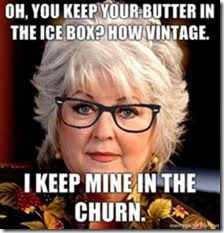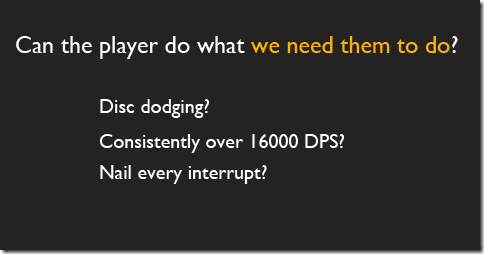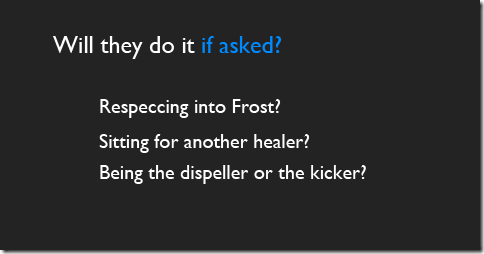Whether it’s Rift, WoW, or Star Wars: the Old Republic, guild problems and solutions can be carried over from one game to the next. Having organizational skills are crucial to being an effective guild leader.
I went around and had an open call with several guild leaders in the community to see if they had specific advice to offer to anyone who wanted to be a guild leader (Many of them started off with “Don’t do it”).
Think long term
Well planned guilds have long term commitments from the leadership. I’d classify long term as something over a year. Conquest has been around for almost 3 years. It wasn’t something I wanted to just do for 6 months. I wanted to commit to it over a long period.
The top bit of advice I can give is find your essence and let it guide you. Find what makes your guild truly unique and special, and be proud of it. That essence isn’t your ranking, or how progressed you are – it’s what makes the people and the team a fun place to be. My guild, Imperative, started with an essence of serious college gamers with a light schedule, and even a year later, we’ve still got that one core.
Don’t ever sacrifice that essence for short term success. Think in the long-term. Starting now, don’t think about making a “successful guild in Firelands” – think about making a kick-ass guild in patch 4.5, or the next expansion. We have an old saying that “progression is a marathon, not a sprint.”
As a guild leader, you have quite a responsibility: you will be solely responsible for the happiness of several people for multiple hours each week. People are going to look to you for the enjoyment of their hobby. At times, it’s easy to feel that burden and consider quitting. At times, every leader will get a feeling of burn out and think that the costs outweigh the benefits. Just remember that what you have is real, even if it exists within “just a game.” There is an essence to your team that can never be recreated, and it has value beyond the game.
Blacksen, Imperative
Delegate what you can
For some players, assisting comes naturally. In other cases, it’s best to outline exactly what you need your officers to do. They want to help but may not know what boundaries they shouldn’t cross.
If you’ve never been an officer before, you will be absolutely overwhelmed with the amount of time you will need to dedicate to your guild as the guild master.
The best piece of advice I can offer an aspiring or new GM is to delegate. Delegate, delegate, delegate. I’m a bit of a control freak myself, so it’s difficult for me to delegate, but surround yourself with people you trust for officers, and give them very clearly-defined duties. If you’re not the raid leader, refer ALL questions regarding raiding to that officer. If you’re not the bank administrator, refer ALL bank questions to your bank officer. If you’re not the caster DPS lead, refer ALL questions concerning caster stuff to that officer. See the pattern?
Kurn, Apotheosis
Pace yourself
While some organization is important to have from the beginning, take a bit of time off and actually play the game. It’s not a bad idea to have a dry run of different policies to see how effective or received it’ll be by the crew.
Start slow. Don’t try and create the entire guild structure, loot system, various rules all at once. All guilds started as a group of friends just wanting to get together and play some World of Warcraft. If you have goals, lay them out and set out to accomplish them. However, if you spend all your time setting everything up, you’ll never get around to doing the fun part that keeps people coming back every week: killing bosses.
You won’t see all the bad (or good) situations that will come up through the course of your tenure as GM, so don’t try to look for them. Shoot from the hip and go with what feels right for you and your team.
Borsk
Manage Expectations
Lay down tangible goals. Set out deadlines. Anything that helps indicate progress is good because players want to feel like they’ve actually accomplished something.
Setting expectations is key to a solid leadership foundation. By managing guild member’s expectations, you can mitigate disappointment and set the stage for exceeding expectations. People enjoy a sense of accomplishment, needing it as a component of motivation. If you set expectations that cannot be achieved, there will never be a sense of accomplishment. On the other hand, setting expectations that can be successfully met will lead to people achieving the expectation, gaining a sensing of accomplishment, and providing them an opportunity to exceed expectations, further contributing to their self motivation for success.
Within my guild, the expectation was set that we would hope to start 25m raiding within 1 month, allowing plenty of time for people to get to level 85 at their own pace without the pressure of having to take time off work or sacrifice spending time with friends/family during the Christmas/New Years. The reality turned out to be 30 excited nerds hitting 85 within two weeks and two 25m bosses down in the 2nd week of release. This far exceeded all expectations that had been set, invigorating the guild with a massive sense of accomplishment and injecting an incredible amount of motivation.
_M
Invite with Caution
It’s entirely possible to fire off too many invites at a time. This can be counter-productive to your cause. While low barriers of entry are okay, at least some player standards should be maintained. I’m not referring to just gamesense or players skills. Being in your guild should be a privilege.
Back in the mid-BC days, I cycled through 5 raiding guilds in as many months simply because they fell apart. They got too big too fast, a group of 4 or 5 people quit in rapid succession, or the better raiders spread themselves into too many teams leading to progress stalling, the symptom could be any of the above (or something similar that I didn’t mention). If you want to start a successful raiding guild: guard your ginvites closely. After going through a new guild every month, I got sick of the transitions and, along with a few friends, founded a raiding guild that, at most, recruits 2 new players a week (though most weeks we didn’t recruit at all). I’m still a proud member of that guild today, 3 years later (and am now the guild leader).
If you guard your ginvites, your members begin to understand that while you might use the occasional pug, being a guildie is something special. This in turn fosters a sense of community that makes raids and 5-mans more enjoyable. It also makes for a nice reason for them to stick around when progress stalls (we all have hiccups in progression every so often). One team of ours bashed their heads against the Lich King fight for a solid month and not one person left the guild (this was before the guild rep system, so they could’ve jumped to another guild without any long term problems). In short, be selective about your ginvites. You can group with anyone, but guildies should be a step above the rabble.
Zet
Recruit like minded players
Heard of the phrase birds of a feather will flock together? It applies here just as well. Having similar interests with someone helps lower resistance and it ensures everyone is on the same page. Plus it cuts down on the drama. No one’s going to complain about hating PvP if all the players are into PvP.
Have your mission all laid out? Then you can focus on surrounding yourself those that help drive that mission forward. What sort of people would best fit and are like-minded to your mission? You wouldn’t recruit a bunch of casual players if you ultimately want to become a raiding guild in the top 10 guilds on your server, would you? Its nearly impossible to survive, recruit, and ultimately be a leader who others trust and respect without this defined.
Our raiding guild has several officers who are all raid leaders, all equal, very flat organizational structure. We have a level 1 guild master as a placeholder only because we have to. We formed and lead the guild as a team and make decisions that way, period. Not all guilds follow a “cookie cutter” approach, it’s important to take the time to really define what fits with your guild’s mission.
Bottom line? Start with a focus on defining your mission and build the guild around it with people just as passionate about it as you.
Gina, Healbot, <Cold Fusion>
Establish your guild’s “identity”
Before selecting your leadership base, it’s a good idea to figure out what you want to do. Don’t try to be everything. At least, not right away.
Are you a casual guild?
Hardcore raiding?
PvP?
Amazingly, once you’ve established what kind of community you want to build, the rest of the pieces will really begin to fall into place. Finding people who share this vision with you in the beginning will really shape how your guild grows. In a Cataclysmic-world, guilds are more than just tags floating above your head, they’re identities. Finding the right guild and sticking with it now has actual tangible benefits beyond just a great social hub and people are (as they should) not taking the decision as lightly. Attracting like-minded individuals who really care about the growth and development of your new guild is important and these people will become your officers at some point.
The Magette
Pick the right person for the right job
Personalities matter. It’s not enough for everyone to buy into the philosophy. Your leaders need to exude the right qualities to appropriately carry out their duties. Putting the really shy guy on the job of evaluations and feedback is not exactly the best combination.
Any guild should not need more than 1 officer per 5-8 players. Example: a 20 – 25 player roster (which should amount to 80-100 characters) should have no more than 3-5 officers). Be sure to pick the right person for the right job because your in game or RL friends may not be best fit. Just because someone is a nice person or great player doesn’t mean they are right. A great player could have a condescending tone and attitude, but would not be the right person for an officer whose tone can easily be misconstrued. On the flip side, a friendly sub-par player with the awesome personality may not have enough clout to provide the right constructive criticism.
In short, it’s never easy to pick the leadership core, but it is an first important step.
Quori
Check discipline
Be clear with the rules and watch the grey areas. While leaders do their best in enforcing policy, not everything gets caught. There’s all sorts of disciplinary action that can be taken. Be careful what you do and how you do it.
Depending on your guild set up and recruitment process, it should be made clear what the guilds rules are and what any disciplinary actions may be for breaking the rules. This way if anyone breaks the rules you have a clear course to follow without having to think too much about what to do and by doing so it adds some structure to the guild. No exceptions should be made to the rules or the whole thing will fall into disrepute. An example from my guild is that we have a “No Loot Ninja-ing either in our raids or any PuG you might run while in our guild” – on person ran a VoA pug and ninja’d some loot, which came back to me and I G/kicked him without remorse, as per the guilds rules – which went down well on our server.
Valilor, Aggro my Own Vegetables
Stop trying to do everything
There’s enough responsibility to go around. You know you have too many officers when there’s someone who is sitting around not really doing anything because anything that needs to be done is already done.
Don’t make the mistake of wearing too many hats – if you end up as the Recruitment officer, the website maintainer, the raiding coordinator, the PR officer, the guild bank organiser and especially the guild sounding board, burnout is inevitable. Little things, like making sure that multiple people can update the guild website, will ease daily pressure on you. Logging on to a dozen small issues every day will whittle away at your patience and free time, and make you feel tense at the idea of logging on or checking the forums. Ask yourself if there are tasks that you can delegate, share, or roster – partly to avoid burnout, but also so that if you have to go away, your guild isn’t left with a gaping hole in its management team.
Keeva
Listen
Disagreements are going to happen. Having a group of all yes-men isn’t the best idea. Use them as a sounding board and take into heart what your players have to say before carrying through. Every risk has a possible reward. Every action has a consequence. It’s up to you to decide if it’s worth it.
Who will these yes-men be? Sometimes it may be obvious as your RL BFF, spouse, that dude you have run with since Vanilla, or maybe someone you’ve met fairly recently. Start with a small officer core and take time to work through at least the main start-up issues with these people. You may even want to get the guild up and running a bit before expanding the leadership.
Be aware that not everyone – even your BFF – is cut out for guild leadership – and that may not be apparent until you are in the thick of things. Be sure that the officers are people that can work through disagreements. If you and your spouse have conflicts with both of you running in the same raid, leading a guild together may magnify that. Real life relationships are more important than a game – don’t forget it. Oh, you thought this would be all peaches & cream? Only if your dictatorship is structured well.
Zaralin, Force of Impact
Thanks to everyone who took a moment out of their day to add their thoughts. I would have added more but some of the responses I received would have constituted a post in itself.
That’s what happens when you ask raiding and GMing bloggers to add one response. They give you a novel.
Our community can be crazy sometimes!




